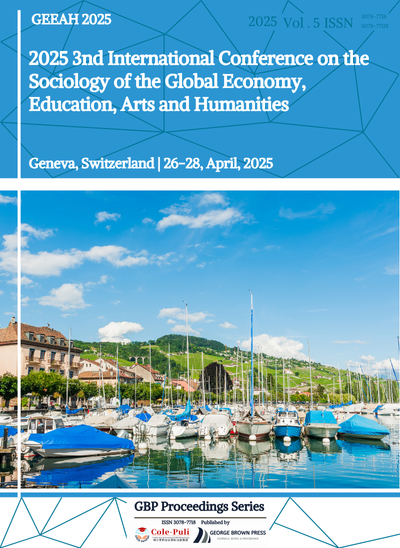Artistic Analysis of the Cello Work Fantasia
DOI:
https://doi.org/10.71222/q07j4m67Keywords:
cello, Fantasia, artistic analysis, performance data analysis, technical challengeAbstract
The research here focuses on exploring the creative background, the structure of music, and the art of the cello composition Fantasia through a literature review and an empirical data analysis. The variety of its thematic material, construction, and expressiveness provided by the score are identified as the primary subjects for observation. We utilized motion-capture and high-resolution audio analysis to perform quantitative assessments of the interpretation behaviors such as tempo fluctuation, intonation, and dynamics. The technical issues involved in the practice like the change of the position of the left hand, different bowing techniques, and the accomplishment of the expressive control are pointed out and explored. The strategies for solving the issues are drawn from the obtained results and through intervention, these are suggested and tested. This demonstrative practice of intervention impact from pre-and post-study intervention on playing fluidly and expressively proves the findings. The research ultimately unearths the core of Fantasia's beauty and performance practice and at the same time provides a new approach to quantitative analysis and pedagogy of cello repertoire.
References
1. G. Smyth and G. Smyth, “Joyce and music: A critical fantasia,” Music Sound Lit. Life James Joyce: Joyce's Noyces, vol. 1, pp. 3–40, 2020. ISBN: 9783030612054.
2. S. P. Leong, “Fantasy aesthetic and Franz Schubert’s ‘magical’ transitions in sonata forms,” J. Musicol. Res., vol. 42, no. 1, pp. 23–44, 2023, doi: 10.1080/01411896.2023.2202819.
3. G. Bigashev, “Sonatina for cello and piano by Zoltán Kodály in the light of stile evolution,” Eurasian Music Sci. J., no. 2, pp. 133–147, 2020, doi: 10.52847/EAMSJ/vol_2020_issue_2/A13.
4. M. Skrebkova-Filatova, “About some texture and harmonic processes in the piano music of romantic composers after the example of Chopin's music,” in Proc. 1st Int. Conf. Arts Des. Contemp. Educ. (ICADCE), May 2015, pp. 264–267. ISBN: 9789462520783.
5. C. S. Kim, “Formal excess in the opening movement of Fanny Hensel’s string quartet in E♭ major (1834),” Music Theory Spectr., vol. 45, no. 2, pp. 218–237, 2023, doi: 10.1093/mts/mtad007.
6. W. W. Cobbett, “Chamber-music,” Proc. Musical Assoc., vol. 38, no. 1, pp. 93–116, 1911, doi: 10.1093/jrma/38.1.93.
7. L. Frăţilă, “Development of the sonata genre in Frederic Chopin’s creation,” Bull. Transilv. Univ. Braşov, Ser. VIII: Perform. Arts, vol. 13, no. 1, pp. 65–74, 2020, doi: 10.31926/but.pa.2020.13.62.1.7.
8. S. Karkina, “Subject-oriented approach to improve the professional competencies of music teachers,” Eur. Proc. Soc. Behav. Sci., 2017, doi: 10.15405/epsbs.2017.08.02.41.
9. D. Osmond-Smith and T. P. Berio, “Two fragments of ‘The Music of Luciano Berio,’” Twent.-Century Music, vol. 9, no. 1–2, pp. 39–62, 2012, doi: 10.1017/S1478572212000199.
10. K. Uhde and R. L. Todd, “‘I'm workin’ on my buildin’: Freedom and foundation-building in Florence Price's two violin fanta-sies,” J. Soc. Am. Music, vol. 17, no. 3, pp. 243–260, 2023, doi: 10.1017/S1752196323000226.











